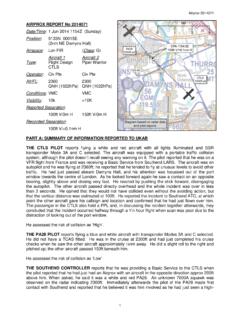Transcription of AIRPROX REPORT No 2013123 Coventry 2nm C172
1 1 AIRPROX REPORT No 2013123 Date/Time: 27 Aug 2013 1452Z Position: 5225N 00122W (5nm NE Coventry Airport) Airspace: London FIR (Class: G) Reporting Ac Reported Ac Type: ATP C172 Operator: CAT Civ Pte Alt/FL: 3000ft 4000ft QNH QNH Conditions: VMC VMC Visibility: >10km >10km Reported Separation: 500ft V/NK H 250ft V/350m H Recorded Separation: 500ft (925m) H PART A: SUMMARY OF INFORMATION REPORTED TO UKAB THE BAe ATP PILOT reports being pilot flying on a COWLY departure for RW05 from Coventry airport (CVT) on an IFR flight under the control of Coventry Approach Radar. Strobes, navigation and two taxi (wing leading edge) lights were illuminated. SSR Modes C and S were selected. On approaching the Coventry CT NDB he was given traffic information: C172 right two o clock 4000ft . He was climbing to 5000ft and received the traffic information at approximately 2500ft.
2 The aircraft was not visual but was displayed on TCAS. As he turned right at the CT NDB from 050 onto 180 , at approximately 3000ft (and passing 090 ) he received a TCAS TA. This was followed shortly afterwards by a TCAS RA to monitor vertical speed (V/S) 0 to -300fpm; this was actioned whilst also levelling the wings and stopping the turn. Once clear of conflict, departure routeing and climb profile were resumed. He assessed the risk of collision as High . THE CESSNA 172P (C172) PILOT reports being on a VFR flight to Tatenhill. His aircraft was coloured predominantly white; strobes and tail beacon were illuminated and SSR Modes C and S were selected; TCAS was not carried. He was cruising at 4000ft QNH, receiving a Basic Service from Coventry Approach, which was obtained whilst over Banbury. His route was direct from Draycott Water Visual Reference Point to Tatenhill, passing the CT NDB heading approximately 330.
3 He was informed that an ATP was departing Coventry currently at 2500 ft and would be climbing through his altitude. He replied looking and saw the ATP in the climb crossing left to right well in front of him. He was not able to respond to ATC immediately that he had the aircraft in sight as the RTF was busy but he later reported visual contact. He expected the aircraft to climb on runway heading. He continued with a sky and instrument scan, and again focussed on the ATP, which now appeared to be turning right. He then continued to watch as the aircraft kept turning right in the climb. He thought that there may be a conflict and disconnected the auto pilot to enable him to take rapid avoiding action if required. At the point where the aircraft stopped the turn he was about to turn hard left, but conscious that if he did so he would lose visual contact.
4 The aircraft passed down his right side, maybe 500 ft below his altitude. He assessed the risk of collision as Low . Diagram based on radar dataATPCPA 1452:22500ft HA23NM012C1724000ft alt1451:2251:3451:4651:5852:10A27A30A33A 36A35 Coventry 2nm2 THE Coventry APPROACH RADAR CONTROLLER reports that the ATP was released to altitude 5000ft to follow a COWLY 05 Standard Departure Route (SDR). Traffic information was passed to the C172, which was being provided with a Basic Service. The ATP was identified on departure, and a Traffic Service was provided. Traffic information was issued on three occasions about the C172, transiting South to North at 4000ft. At 1452 the ATP pilot reported receiving a TCAS RA. He descended to 3400ft, resuming climb when he was 3nm S of the C172. The ATP pilot reported he would be filing an AIRPROX REPORT .
5 The C172 pilot confirmed he had been visual with the ATP since it had passed 2500ft. Factual Background The Coventry weather was: METAR EGBE 271450Z 36006KT 320V050 9999 SCT048 22/10 QNH1019= CAP 774-Flight Information Services describes the following services: Basic Service1. Pilots should not expect any form of traffic information from a controller/FISO, as there is no such obligation placed on the controller/FISO under a Basic Service, and the pilot remains responsible for collision avoidance at all times. However, on initial contact the controller/FISO may provide traffic information in general terms to assist with the pilot s situational awareness. This will not normally be updated by the controller/FISO unless the situation has changed markedly, or the pilot requests an update. A controller with access to surveillance-derived information shall avoid the routine provision of traffic information on specific aircraft, and a pilot who considers that he requires such a regular flow of specific traffic information shall request a Traffic Service.
6 However, if a controller/ FISO considers that a definite risk of collision exists, a warning may be issued to the pilot . Traffic Service2. A Traffic Service is a surveillance based ATS, where in addition to the provisions of a Basic Service, the controller provides specific surveillance-derived traffic information to assist the pilot in avoiding other traffic. Controllers may provide headings and/or levels for the purposes of positioning and/or sequencing; however, the controller is not required to achieve deconfliction minima, and the avoidance of other traffic is ultimately the pilot s responsibility. The controller shall pass traffic information on relevant traffic, and shall update the traffic information if it continues to constitute a definite hazard, or if requested by the pilot. The Rules of the Air Regulations 2007 states that: notwithstanding that a flight is being made with air traffic control clearance it shall remain the duty of the commander of an aircraft to take all possible measures to ensure that his aircraft does not collide with any other aircraft 3.
7 Also when two aircraft are converging in the air at approximately the same altitude, the aircraft which has the other on its right shall give way 4. Analysis and Investigation CAA ATSI An AIRPROX was reported in Class G, uncontrolled airspace, by the pilot of an ATP shortly after departure from RW05 at Coventry Airport when he came into proximity with a C172, which was crossing the climb-out from south to north. The ATP pilot was operating IFR on a [freight] flight from CVT; was displaying SSR code 6257 and was in receipt of a Traffic Service from CVT Radar on frequency The C172 was on a VFR flight to Tatenhill airfield, was displaying SSR code 4361 and was in receipt of a Basic Service from CVT Radar on frequency 1 Chapter 2 2 Chapter 3 3 Rule 8 (1)-Avoiding aerial collisions 4 Rule 9-Converging 3 ATSI had access to area radar recordings, written reports from both pilots and the CVT Radar controller together with an RTF recording and transcript of the CVT Radar frequency.
8 ATSI also interviewed the CVT Radar controller. At 1435:50 the C172 pilot contacted CVT Radar requesting a Basic Service. The C172 pilot was tracking towards Draycott Water and onward to Tatenhill at 4000ft. The C172 pilot was given a squawk of 4361 and a Basic Service was agreed. At 1448:30 the ATP was released by the Coventry Radar controller to climb to 5000ft on a COWLY 05 departure which climbs on track to the CT NDB before a right turn to intercept the Compton (CPT) VOR R355 to CPT D30. Fig 1 shows the position of the C172 (squawking 4361) at the time of the ATP s release together with the direction of the 355 radial to CPT. Figure 1. At 1450:30 the C172 pilot was passed traffic information, airborne from Coventry off runway zero five is an ATP climbing through your level to altitude five thousand feet . The C172 was at 4000ft, to the east-southeast of the ATP (Fig 2).
9 Figure 2 4 At 1451:10 the C172 pilot was again passed traffic information on the ATP stating that it was, now left ten o clock range of two miles, two thousand feet in the climb through your level (Fig 3). The pilot replied that he was looking. Figure 3 At 1451:21 the ATP pilot contacted CVT Radar passing 2500ft climbing to 5000ft. A service was not agreed between the Radar controller and the ATP; however, the ATP pilot was informed of traffic, right two o clock range of three miles northbound at four thousand feet Cessna one seven two. At 1451:52 CVT Radar updated the traffic information to the ATP pilot as, now right half past two two miles right to left at four thousand feet . The ATP was passing 3100ft, to the northwest of the C172 (Fig 4) and reported that he was not visual with the C172. Figure 4. There was a crossed transmission between the controller and the ATP pilot before, at 1452:10, the traffic information was updated to the ATP pilot stating that the C172 was, now right one o clock one mile at four thousand feet (Fig 5).
10 The ATP pilot reported receiving a TCAS RA, which was acknowledged by the controller. 5 Figure 5. The two aircraft continued to converge as the ATP turned right. The CPA was horizontal and 500ft vertical, as shown by the Clee Hill radar replay (Figs 6 and 7). The aircraft passed each other and the ATP pilot continued his climb to 5000ft. Figure 6. Figure 7. At interview, the Radar controller stated that at the time of the ATP s release he was aware of the C172 but did not consider that it would cause an issue to the ATP. Traffic that is released by Birmingham, prior to departure, is required to become airborne within 2 minutes of the release. The controller s impression was that the ATP took longer than normal to become airborne, although he also acknowledged that there was time to alter the release before it had departed or was transferred to Radar.















